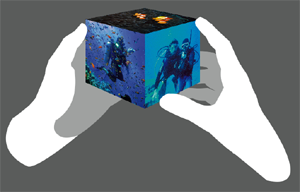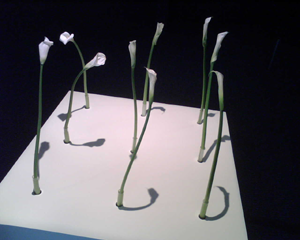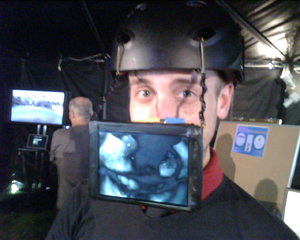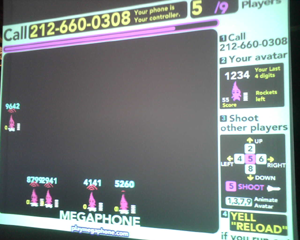 Yahoo Design Week started today. The week brings a handful of young design students to Yahoo’s corporate campus to show off their final projects to a crowd of press and employees. The students are from a variety of backgrounds and geographies, some coming from as far away as the Indian Institute of Technology and the Academy of Media Arts in Germany.
Yahoo Design Week started today. The week brings a handful of young design students to Yahoo’s corporate campus to show off their final projects to a crowd of press and employees. The students are from a variety of backgrounds and geographies, some coming from as far away as the Indian Institute of Technology and the Academy of Media Arts in Germany.
Joy Mountford has been running design weeks at various companies for the past 18 years. This week, she’s running Yahoo’s Design Week as the Vice President of User Experience Design and Design Innovation Group. She runs the programs to help spark new ideas around human-computer interaction and strengthen their ties with up and coming designers. Like HackDay, Design Week is tied closely with the Brickhouse group, the idea incubator Yahoo launched earlier this year.
Over many years of running the program Joy has noticed one great theme: the convergence of design and engineering. The first projects often needed a team of designers and programmers to bring the idea from design to implementation. Even still, they didn’t always match up with the originally conceived idea. But programming is becoming easier. Most of the teams now consist only of one or two members using a visual programming language out of MIT called Processing.
We’ve seen this trend in spades on the net, from single installation development platforms to the latest easy-as-pie mashup applications. New tools are empowering users and designers to fix problems they used to have to seek specialized programmers to solve.
The projects ranged from the practical to the perplexing. Here’s a roundup of some of the more entertaining projects at the event:
Cube Browser
 CubeBrowsers is a photo cube and Flickr mashup controlled by a real cube.
CubeBrowsers is a photo cube and Flickr mashup controlled by a real cube.
By rotating a physical white cube you control the photos displayed on the virtual photo cube. Shaking the cube vigorously populates the sides of the cube with Flickr photos from a random tag.
Rotating left or right moves forward and backward through the set. Rotating up changes to a new set on a related tag. Rotating down goes back in the history.
Whisper
 Whisper was the most intriguing project at the exhibit. It featured spartan garden of 9 Calla lilies on a white slab. If you moved close enough to put your ear to the flower you could hear a woman moaning. Literally – they play the sound of a woman moaning sexually through the flowers.
Whisper was the most intriguing project at the exhibit. It featured spartan garden of 9 Calla lilies on a white slab. If you moved close enough to put your ear to the flower you could hear a woman moaning. Literally – they play the sound of a woman moaning sexually through the flowers.
Think Georgia O’Keeffe 2.0.
The lillies carried the sounds from speakers placed under each flower below the surface. This was one of three installations UCLA grad student Jay Yan had made.
StreetStory
StreetStory was spawned from another HackDay project PlacesToDo. PlacesToDo let you catalog interesting places by emailing them to the website from your mobile phone. Then, while your out, you could SMS the service for interesting places suggested by you or your friends within a five block radius of your current location.
StreetStory was a reaction to people’s reluctance or confusion over emailing the service. The new service allowed anyone to call in their thoughts about an area tagged by zipcode. Anyone can retrieve these messages by calling the service or visiting the website. Like every other mobile application, they have plans for an iPhone version that will take advantage of the phone’s heavy web integration.
In the future, the site could easily become a real-time reviews service where people could call in their complaints or compliments about any movie or restaurant they just finished with.
Experimental Devices for Performance
 Andrew Schneider started as a street performer before going to design school at NYU and it shows. His project was an array of 5 types of sensors attached to his body. The sensors picked up movements he can use to cue music and visualizations on a laptop. A jut of the elbo would shoot off a record scratch. A twist of the wrist could set off a movie on the monitor. Another gadget is a pair of face masks with lcd screens that can trade lips with each other (pictured right).
Andrew Schneider started as a street performer before going to design school at NYU and it shows. His project was an array of 5 types of sensors attached to his body. The sensors picked up movements he can use to cue music and visualizations on a laptop. A jut of the elbo would shoot off a record scratch. A twist of the wrist could set off a movie on the monitor. Another gadget is a pair of face masks with lcd screens that can trade lips with each other (pictured right).
The highlight was a pair of shoes he could use to control the tempo of accompanying music by lifting or dropping his heels. They’re the perfect moon walk accessory.
Andrew uses the accessories in his NY street performances.
MegaPhone
 Mobile games are big business, but have traditionally been confined to the phones they’re stored on. MegaPhone is a download-free game where players compete on a projection screen by calling in and manipulating their spaceship through shouting and keypad. The keypad controls the movement of the spaceship while yelling causes it to fire.
Mobile games are big business, but have traditionally been confined to the phones they’re stored on. MegaPhone is a download-free game where players compete on a projection screen by calling in and manipulating their spaceship through shouting and keypad. The keypad controls the movement of the spaceship while yelling causes it to fire.
There are also a few other existing games. There are trivia and shooting games that just require the keypad, while a taxi and noisy noisy hippo game respond to your shouting.
The service seems perfect respite for people cuing up in large public areas like movie theaters or concert halls. You can see their demo site here.
Identity Protection System (IDPS)
 Privacy is becoming a hot button issue, with the heat lamp currently shining on search engines. IDPS goes after another rapidly growing encroachment on personal privacy, video broadcasting. Current technology requires editing out people who don’t want to show up on film. IDPS does this editing on the fly by blocking out the bodies of people wearing a specially colored green sticker.
Privacy is becoming a hot button issue, with the heat lamp currently shining on search engines. IDPS goes after another rapidly growing encroachment on personal privacy, video broadcasting. Current technology requires editing out people who don’t want to show up on film. IDPS does this editing on the fly by blocking out the bodies of people wearing a specially colored green sticker.
The sticker, or any other unique feature spotted by computer vision, could be placed on shirts and jewelry, opting the wearer out of being filmed.